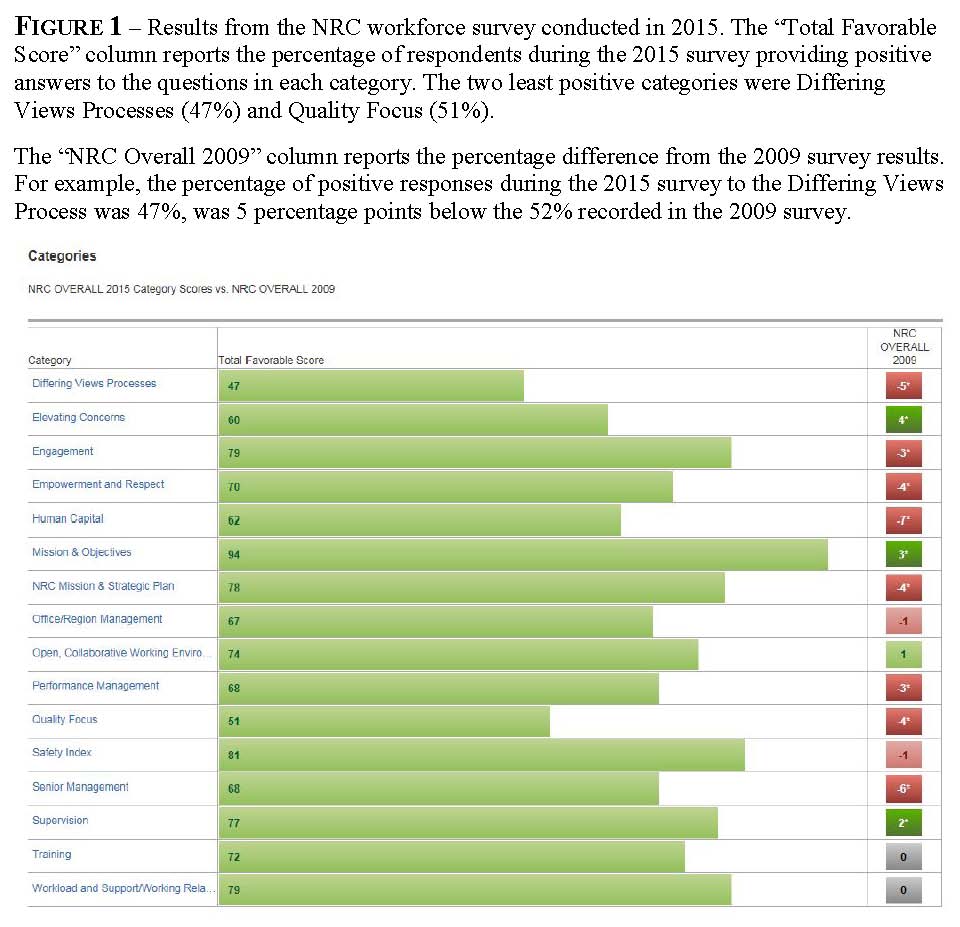Many times over the past 20 years the Nuclear Regulatory Commission (NRC) has intervened when evidence strongly suggested a nuclear power plant had nuclear safety culture problems. The evidence used by the NRC to trigger its interventions was readily available to the plant owners, but the owners had downplayed or rationalized away the evidence until the NRC forced them to face reality.
The evidence used by the NRC to detect these nuclear safety culture problems included work force surveys indicating a sizeable portion of workers reluctant to raise safety concerns and allegations received by NRC from workers about reprisals and harassment they experienced after raising safety concerns.
Ample evidence strongly suggests that the NRC itself has nuclear safety culture problems. The NRC’s Office of the Inspector General (OIG) has surveyed the safety culture and climate within the NRC every three years for the past two decades. The latest survey was conducted during 2015 and released in March 2016. Figure 1 from the OIG’s 2015 survey along with data from the annual Federal Employee Viewpoint Surveys and other sources show safety culture problems as bad as—it not considerably worse—than the worst safety culture problems identified at Millstone, Davis-Besse, and yes, even the TVA reactors.

FIg. 1 (Source: Nuclear Regulatory Commission Office of the Inspector General)
After the OIG’s 2009 survey of the NRC’s safety culture and climate, UCS submitted a request under the Freedom of Information Act for all records related to the actions taken by the agency in response to the survey. We obtained many records which described very few actions. And regardless of the number of actions, the OIG’s 2015 survey showed that the NRC’s safety culture was worse than in 2009 (see the last column on the right in Figure 1).
Why would the NRC take steps to remedy safety culture problems at nuclear plants yet have taken no steps to remedy its own safety culture problems? The answer is the same as to the question of why the plant owners failed to take steps to correct safety culture problems before the NRC intervened—they did not perceive the problems to exist. Likewise, Figure 2 shows that the NRC’s senior management does not perceive safety culture within the agency to need remediation.

Fig. 2 (Source: Nuclear Regulatory Commission Office of the Inspector General)
The OIG employs a consultant to conduct the triennial safety culture surveys. I attended a briefing several years ago by the consultant on the survey results. The consultant reported surveying many other federal agencies and large private corporations. The consultant pointed out that the gap between results by senior management and by the overall workforce was wider at NRC than at any other federal or private entity it had surveyed.
Just as plant owners failed to correct the problem they could not see, NRC senior management cannot fix the agency’s “invisible” safety culture problems. The NRC intervened to enable owners to see, and then fix, their safety culture problems. Someone needs to intervene to help NRC senior management see the agency’s safety culture problems so they can take the corrective measures they have often compelled plant owners to take.
UCS recently issued a report on the NRC’s safety culture problems and its history of inducing safety culture fixes at nuclear plants. And The Bulletin posted my commentary about the NRC safety culture report.
If I found a lamp washed up on a beach and rubbed it to release a genie who granted me three wishes, my first wish would be for irradiated fuel to be transferred from dangerous, overcrowded spent fuel pools into more safe and secure dry storage as soon as practical. But my second wish would be for the NRC to undertake the reforms needed to achieve and sustain a positive nuclear safety culture at the agency. My third wish would be for a thousand additional wishes, so don’t worry that I squandered my first two.
